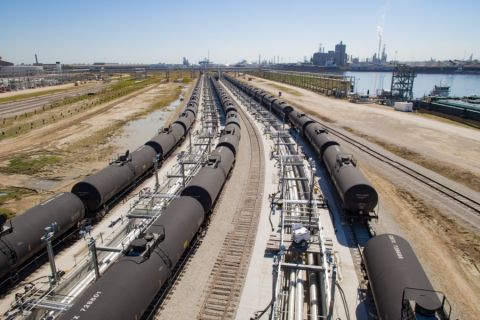
Since the two-and-a-half-mile lateral’s introduction in the Permian Basin in 2017, longer laterals are becoming the more popular option among operators due to lower operational costs. (Source: Hart Energy)
Presented by:

This article appears in the E&P newsletter. Subscribe to the E&P newsletter here.
FORT WORTH, Texas—In the Permian Basin, the popularity of longer laterals is slowly but steadily rising, according to Rystad Energy’s upstream research analyst, Cole Wolf.
The two and a half-mile lateral emerged in the Midland Masin in 2017, growing in quantity and length until it accounted for 16% of the laterals drilled in the basin in 2021. Similarly, in the Delaware Basin, the first 12,500-ft laterals appeared in 2018, ultimately comprising only 2% of the laterals drilled in the basin in 2021.
Wolf spoke on May 17 at Hart Energy’s DUG Permian Basin and Eagle Ford conference and exhibition about the impact the three-mile lateral is making in the Permian, as well as the economic and efficiency advantages simul-frac has over zipper frac.

“If we look to the future and the number of projected and submitted posts, wells and in permits, we can see that in both the Midland and Delaware basin, there is still interest by operators to continue practicing these two and a half and three mile laterals,” Wolf said.
Focusing on horizontal permits issued in first-quarter 2022 in the Permian, 95 permits for laterals of 12,500 ft or longer were issued in the Midland Basin as well as 31 in the Delaware Basin.
“Looking at that portion of 12,500 ft or longer for proposed lateral length,” Wolf continued, “what we see is there’s still significant activity going on in Midland Basin, and then some tests going on in the Delaware Basin, although the opportunity there looks to be quite promising.”
Although longer laterals are gaining footing in the Midland and Delaware basins, they have yet to yield the levels of gross production operators were hoping to achieve. However, this is predicted to change further down the line, Wolf said.
In taking a closer look at the sub-basin median six-month recovery per foot data between 2020 and 2021, there was a decrease in productivity per foot correlated with the length of the lateral.
In the northern Midland Basin, laterals ranging from 5,500 ft to 8,500 ft produced 23.8 bbl per foot, comparable to 18.1 bbl from laterals of 12,500 ft or longer, resulting in a 16.2% degradation in productivity. The southern Midland sub-basin and the Texan and New Mexican Delaware sub-basins yielded similar decreases, ranging from 8% to 24%.
However, after about five to six months of cumulative production, the trends begin to even out, suggesting that after about a year or year and a half, the productivity results will become comparable to other laterals of shorter lengths. Wolf predicts that around the two-year mark of production, the degradation results will range closer to 5% to 8%.
“After about the five to six month mark of cumulative production, we see that all the curves tend to normalize out,” he said. “So, if you take these tests that have been going on recently in 2019 and in 2021, and push them out to the year, year and a half mark of productivity metrics, you might be able to see some very comparative results.”
In terms of costs, operators can see a “significant reduction” in cost per boe extracted when increasing the lateral length from one mile to two miles, with additional marginal improvements if they choose to extend it further to three miles.
“Therefore, justifying the opportunity to continue joining these laterals further and further if the production is there, and the cost for boe extraction is also relatively the same ballpark,” Wolf added.
With inflation playing a sizable role in operators’ spending, longer laterals could be a solution to offsetting inflationary costs. Through 2023, inflationary costs are expected to continue to rise throughout most aspects of the supply chain, including drilling services, bringing opportunities for operators.
“We've seen across the board that a lot of operators this year have put into their guidance for capital without changing the drilling activity and upper to the level of 10% to 15% of expected inflationary costs,” Wolf said. “If you look at the advantages that we've seen so far in these three mile laterals, if the production is there, if the cost per boe extracted, there could be a combination to kind of counteract some of these inflationary costs that are going on.”
Recommended Reading
Pembina Pipeline Enters Ethane-Supply Agreement, Slow Walks LNG Project
2024-02-26 - Canadian midstream company Pembina Pipeline also said it would hold off on new LNG terminal decision in a fourth quarter earnings call.
Williams Beats 2023 Expectations, Touts Natgas Infrastructure Additions
2024-02-14 - Williams to continue developing natural gas infrastructure in 2024 with growth capex expected to top $1.45 billion.
Canadian Railway Companies Brace for Strike
2024-04-25 - A service disruption caused by a strike in May could delay freight deliveries of petrochemicals.
TC Energy’s Keystone Back Online After Temporary Service Halt
2024-03-10 - As Canada’s pipeline network runs full, producers are anxious for the Trans Mountain Expansion to come online.
Enbridge Announces $500MM Investment in Gulf Coast Facilities
2024-03-06 - Enbridge’s 2024 budget will go primarily towards crude export and storage, advancing plans that see continued growth in power generated by natural gas.





